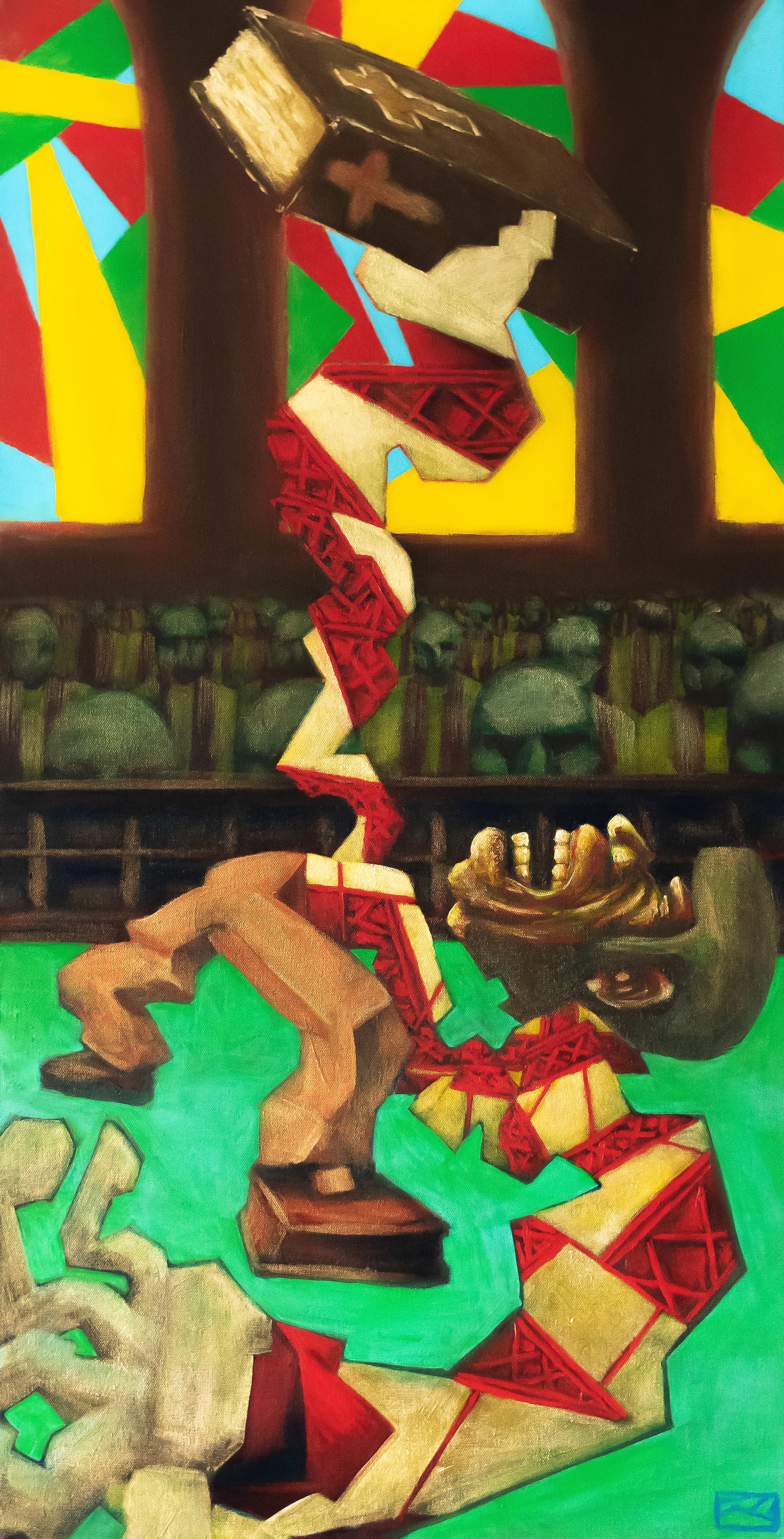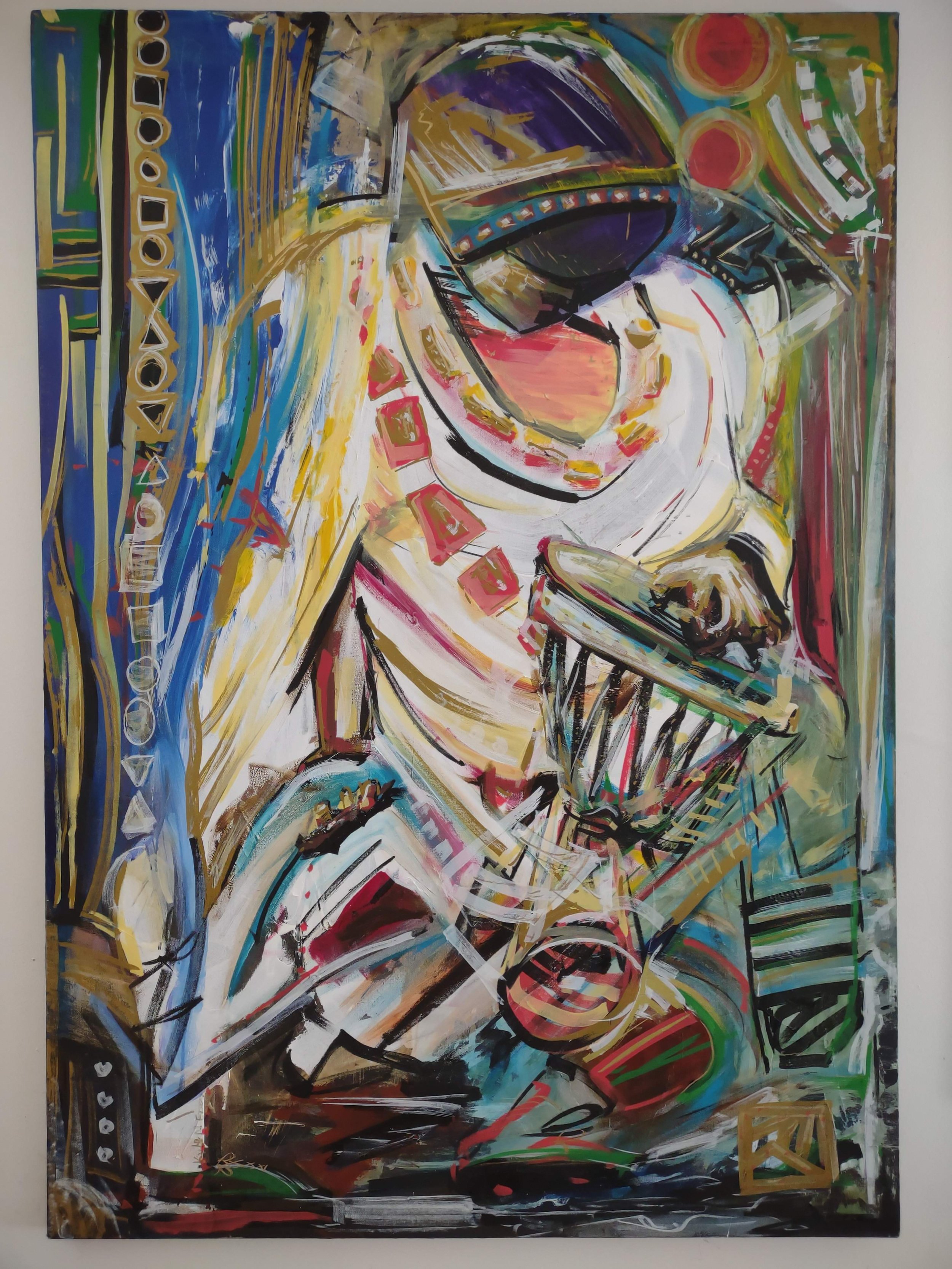Spotlight: Mark Making with Kyle Epps
Photo by: Duron Epps of Epps Graphics
“Mark making,” describes the technique of making lines, dots, patterns, and textures that come together to evoke an image, tell a story, or as Kyle Epps puts it, make an impact. Kyle Epps is a multidisciplinary artist in the Richmond region with an affinity for using his work as a lens to represent life authentically and as an ever-evolving learning process.
CultureWorks: Who are you and what's your story?
Kyle Epps: My name is Kyle Epps. I am a freestyle artist, and a performance artist. I do music production, live painting, sculpture, and installations. I have a broad range of work throughout the years, and I've been an artist for 15 years professionally. My work represents a spectrum, but mainly Richmond, and I do represent whatever influences me or cultures that I connect with here, which is everybody. As I connect with people, I work.
CW: Tell me a little bit more about your relationship to your creative work as a multidisciplinary artist! What leads you to gravitate towards different mediums or themes?
KE: Life experience. When I think of what causes me to gravitate towards something, I think of universality. I think my beliefs or my understanding of life is just how everything connects and flows together. I don't take any experience as one single experience; everything relates to one another. We build upon our ideas based on what we interact with. My work is that, and I have gone through all these phases or bodies of work and created and cycled around, because, again, in the universe things cycle. So, eventually, I'll be coming back to other bodies of work. These things happen because I am staying in the flow of order versus forcing myself to do something for a specific reason, such as money. The monetary aspect isn't exactly what encourages me, although it does let me know that I'm doing something of value. I'm just living my life.
Photo by: Onajé Baldwin of Onajé Imaging
CW: Is there a particular medium that you are drawn to right now?
KW: The concept [I am working in] right now is called "mark making," as painting. It's about making a mark or making an impact and basically representing life in other ways besides what we usually see. A portrait or photograph is a representation of life, but there are so many other ways to represent it. So, that's what I'm doing right now.
CW: The cycle of life really influences your work. Is there a particular process or mindset that helps you get into creating a piece?
KE: Depending on the piece, there's a lot of work I put into preparing. To me, us sitting here is a piece in a sense where I have to perform as an artist. I have to be a person that knows what he does as an artist. So, there are things that you do; I may look at my website, [to remind myself] this is what I do! In other senses, when I'm doing a painting with a subject, for example, if I was doing a work about you, I would study you. I would learn about you as much as you would want me to know. Then, we would sit down and I would work with you and we would just talk, and I would make marks. The goal is not for me to do a painting, it's to make marks that represent you from the understanding that I've gained, and [the work] will happen. It's what happens naturally versus forcing it and saying this is going to be beautiful; it just will be something beautiful because that's how it all comes together. It's being in a clear state of mind, being in a clear spirit, not putting my ego into something, and just accepting what it is.
CW: Similarly, to the idea of making a work about someone, something, or a place that you know, how have you felt your work connect with your community? Have you discovered anything new in that process as an artist over the last 15 years?
KE: To my own story, I have made a lot of different work for all these years. I've done social commentary, which many people may have connected with, but didn't buy. Even the work that people don't like, they may be connected to in different ways. Now, I'm doing what I want to do, which is communicating something that makes people question whether they really know what they're talking about, regardless of whether they're right. I want people to question, Do I know everything about this subject? Do I understand this? I like to study things to the point of questioning myself. I like to not take things for granted. So, I attempt to make work that is that. The new work seems to appeal to people in that way. It's enticing, and it's different.
CW: There's a lot of color and passion that comes through in your wide range of work. Do you use colors to indicate certain emotions or stories?
KE: Absolutely. In all of my work, the one underlying theme has been about color. Initially, I wouldn't paint with black or white because I was either avoiding racism or, personally, avoiding a color theory. I wanted to paint a spectrum versus painting with these colors or even using it as a scapegoat to say I need to paint this subject white, or I need to add black to this. That made me a better portrait artist. I would use gold and other things to highlight the skin because a highlight changes a face. I love the application of color and the application of paint in general. All my years have been a study; I've studied the many-layered meanings of color, and the many-layered meanings of marks. Simplifying those to be as easily communicated across multiple cultures has been the goal.
CW: In your journey as an artist, what are your thoughts on collaboration? Have you collaborated with any other artists or spaces that made an impact on you?
KE: Tuesday Verses, and Slam Richmond; they are a good poetry group. The Camel, and The Broadberry; I worked with them a long time ago. Common Ground, they don't exist anymore. I think these are the people that were really important at the beginning of my career when I was starving and they helped me do some things. In general, aside from business collaborations, I've worked with other artists. I've had good and bad experiences collaborating with other artists. Times are changing, I don't want to go against that, but I'm iffy about collaborating with people because of my experiences. It's a tough question.
CW: You touched on your beginnings as an artist. Do you have words of wisdom from your experience that you would share with an artist who is starting out and interested in exploring different disciplines of art?
KE: I talk to people a lot about life now; I'm just an accidental life coach. [Art] can be about getting into something that you love and making a living from it, or just enjoying life in general and living life to the fullest. Finding that work-life balance, especially for artists or anybody doing their own entrepreneurship; it is about knowing your value. Know how much you need to do that job, to have your free time, and know how much free time you need. Do the numbers, really sit down and do real-life math. It's tough to do that, but once you have it figured out, it covers you. You feel comfortable in your decisions, and it gives you a totally different peace of mind in doing what you do. I saved and worked hard, so I could afford it. It gives you something to work toward, and that is honestly the best that I can tell anybody, old or young.
CW: When you aren't actively creating work, do you have any practices that help feed your creativity or stay inspired? Especially when you are overwhelmed by other aspects of life that are invading your creative space.
KE: The way I do what I do is I stay present in the moment. I take time to reflect. I take time to plan my future when I'm not around people because there's a chance to learn, and there's a chance to gain. And I study. I'm constantly feeding myself with what people do, and that's why I don't watch social media so much. I've been reading some books, and I'm just a nerd. I nerd out on life! I absorb; that's what I enjoy. I do puzzles to calm my mind, and I exercise. I eat right; like, I'm happy we're at Ellwood's, you know. So, it's honestly nothing special. I just do those things, and I work with people well. I try not to be complicated- even though I am. [Laughs]
CW: You've talked a little bit about social commentaries as subjects to your work in the past. What are some subjects that you have explored or gravitated towards thematically?
KE: I did paintings about social issues that were pertinent to me and my experiences. I don't like talking about the bad stuff, and all my old work honestly was tough pills to swallow and pretty pictures. That was it. I like to stay positive. I'm currently working on a project that has to do with some books I'm reading, such as, "They Were Her Property," "The Delectable Negro," and "Medical Apartheid." These are all about the reevaluated studies of American cultural history. All my work kind has had some of that underlying recently. I'm a big American history buff, African history, African American history, indigenous American history buff. I'm also involved in a nonprofit, which is doing great. Community Food Collaborative is a nonprofit that is supporting Henrico County's food justice program, working with Richmond city, and for collaborative learning with youth. That's my other really happy side project.
CW: What do arts and culture mean to you and why does it matter?
KE: Art and culture means a lot to me. Art is culture, and culture represents and comes from the people. For me, I think art really is a big part of valuing people. How we appreciate art shows how we appreciate each other and how we appreciate what we do in culture. It means a lot to me when people support my art because that means they appreciate what I do or, more importantly, the subject matter that my art is about.
CW: Is there anything else you'd like to add?
KE: I'm open to commissions and public works! I'm here to work with people, so I can always be contacted.
To learn more about Kyle Epps: https://kylemepps.com/









